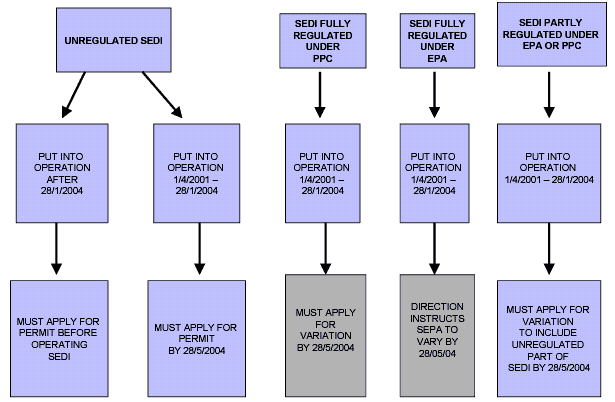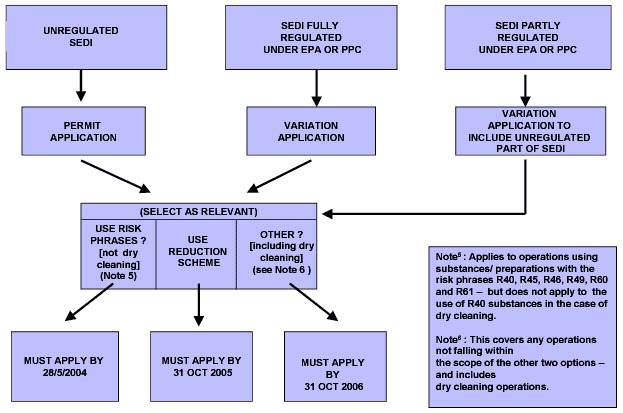Solvent Emissions (Scotland) Regulations 2004: guidance
Guidance on the Solvent Emissions (Scotland) Regulations 2004.
Guidance on the Solvent Emissions (Scotland) Regulations 2004
6. APPLICATION TIMETABLES AND ARRANGEMENTS
6.1 When Should Applications be Made?
Operators of currently regulated SED Installations (i.e. SEDIs already regulated in full or in part under an EPA authorisation or a PPC permit) must apply to SEPA for a variation to include the requirements of the SER 2004, as relevant to their operations, unless SEPA has already included SED requirements (eg as a result of reviewing the authorisation / permit).
Operators of currently unregulated SEDIs must apply for a PPC permit (e.g. dry cleaners).
The SER 2004 does not state specific 'application timescales' for each SER activity. Instead, the date by which the operator is required to apply is determined by a number of factors, including whether the SEDI is 'new' or 'existing'; the nature of the operations undertaken; the type of VOCs used; and how the operator intends to comply with the SER 2004. These factors and the application timescales are detailed further in the following sections.
6.2 Application Timescales for 'New' SED Installations
The date the operator of a 'new' SEDI has to apply is determined by two factors, namely;
whether the SEDI is already regulated (either fully or partly under PPC or EPA); and
when the SEDI was put into operation (i.e. between 1 April 2001 and 28 January 2004, or after 28 January 2004).
In addition SEPA is required, where appropriate, to conduct variations to installations issued with an EPA 90 authorisation between 1 April 2001 and 28 January 2004 to include SED compliant conditions by 28 May 2004.
Figure 2 details the application windows for scenarios where there are 'new' SEDIs.
Figure 2: Application Timescales for 'New' SEDIs

6.3 Application Timescales for 'Existing' SED Installations
The date the operator of an 'existing' unregulated SEDI has to apply for a PPC Part B permit is determined by the 3 factors listed in Table 3 below.
Table 3: Application Timetables for Existing SEDIs
Scenario |
Application Timescale |
The operations involve the use of any substances/preparations with the risk phrases R40, R45, R46, R49, R60 and R61 (but excluding the use of R40 substances/preparations in dry cleaning operations). |
No later than 28 May 2004 |
Compliance with the SER 2004 will be achieved via a reduction scheme. |
No later than 31 October 2005 |
All other operations |
No later than October 2006 |
Table 4: Risk Phrases and Definitions
Risk Phrase * |
Definition |
R40 |
Possible Risk of Irreversible Effects |
R45 |
May Cause Cancer |
R46 |
May Cause Heritable Genetic Damage |
R49 |
May Cause Cancer by Inhalation |
R60 |
May Impair Fertility |
R61 |
May Cause Harm to the Unborn Child |
1. * Taken from the Chemicals (Hazard Information and Packaging for Supply) Regulations 2002 ("CHIP 3")
Figure 3 below details the application windows for the various scenarios for 'existing' SEDIs.
Figure 3: Application Timescales for 'Existing' SEDIs

6.4 Further Application Rules for Existing Installations
There are a number of additional factors which require to be taken into account when determining the date by which an existing installation must make an application to SEPA. These factors are as follows :
Whether VOC abatement equipment has been installed, and when
If a substance allocated a risk phrase is to be used in future
A substance is re-allocated a specific risk phrase
Whether the operation is to undergo a substantial change
These scenarios are explained further in table 5 below
Table 5: Additional Factors Affecting Application Deadline
Scenario |
Current Status of Installation |
Application Timeframe |
Operator has installed VOC Abatement equipment between 1 April 2001 and 28 Jan 2004 |
Regulated (1) |
Application to vary permit/authorisation made by 28/05/2004 |
Unregulated |
Apply for a new permit by 28/05/ 2004 |
|
Operator to install new VOC abatement equipment after 28 Jan 2004 |
Regulated |
Application to vary authorisation/ permit must be made before equipment is installed. (2) |
Unregulated |
Application for new permit made and granted before the equipment is operated. |
|
A substance or preparation in use becomes reassigned to take a relevant risk phrase (3) |
Regulated |
Application for variation to be made within 4 months from the date of reassignment |
Unregulated |
Application for a permit to be made within 4 months of the date of reassignment |
|
An operator wishes to start using a substance or preparation assigned with a relevant risk phrase (3) |
Regulated |
Application for variation to be made and granted before the substance can be used |
Unregulated |
Application for a permit to be made and granted before the substance can be used. |
|
Scenario |
Current Status of Installation |
Application Timeframe |
Operator proposes to undergo a substantial change to the activity (4) |
Regulated |
Application for a substantial change variation made and granted before any change is implemented. |
Unregulated |
Where deemed "new" then application for permit made and granted before change may be implemented Where deemed "existing" then application for permit made in accordance with the timetable set out in Figure 3 above. |
(1) Operators who currently hold a Part A authorisation may apply for a permit for the whole PPC installation rather than the part affected only by SED and may therefore bring forward the timeframe for full transfer of the installation to PPC.
(2) In this scenario the equipment cannot be INSTALLED until the variation to the permit or authorisation has been granted. This is different to the current regimes of PPC and EPA where equipment could be installed but not operated.
(3) This scenario affects any substance which is re-assigned any of the following risk phrases: R40, R45, R46, R49, R60, R61
(4) Operators proposing to use such substances or preparations for the first time will be expected to provide a strong justification against the criteria in Article 7(1) of the SED for why less harmful alternatives cannot be used.
6.5 Expected Dates of Transfer
In recognition of the factors described above it is anticipated that ,with regard to existing installations, the 10 currently unregulated SED sectors (i.e. those sectors not previously regulated under EPA 1990 or PPC 2000) are likely to come into regulation in the timeframes described in Table 6 below :
Table 6: Likely Application Dates for Existing Unregulated SEDIs
Industrial Sector |
Likely Application Date |
|
1 |
Surface cleaning using > 1 tonnes of solvent/yr, with the risk phrases R40, R45, R46, R49, R60 or R61 |
by 28/05/2004 |
2 |
Formulation and/or finishing of pharmaceutical products using > 50 tonnes of solvent/yr |
by 28/05/2004 |
3 |
Rubber conversion not using carbon black using > 15 tonnes of solvent/yr |
by 28/05/2004 |
4 |
Vehicle refinishing using 0.5 - 1 tonnes solvent/yr |
by 31/10/2005 |
5 |
Vehicle coating using 0.5 - 5 tonnes solvent/yr |
by 31/10/2005 |
Industrial Sector |
Likely Application Date |
|
6 |
Coating other than in the course of manufacturing using > 5 tonnes of solvent/yr |
by 31/10/2005 |
7 |
Dry Cleaning (no threshold) |
by 31/10/2006 |
8 |
Surface cleaning using > 2 tonnes of solvents/yr, other than those with the specified risk phrases |
by 31/10/2006 |
9 |
Manufacturing less than 1000m3 of wood products using > 25 tonnes of solvent/yr |
by 31/10/2006 |
10 |
Animal and vegetable oil extraction and purification using > 10 tonnes solvent/yr |
by 31/10/2006 |
6.6 SEPA Variations
Operators are not required to apply for a variation to their authorisation/permit in any of the above circumstances where SEPA has already varied the authorisation/permit to include all necessary SED conditions.
Where the operator does not make an application for variation in respect of a 'partly regulated SEDI' then they must make an application for a permit for the whole SEDI.
Contact
Email: Central Enquiries Unit ceu@gov.scot
There is a problem
Thanks for your feedback